
CasparNetscher was a Dutch portrait and genre painter. He was a master in depicting oriental rugs, silk and brocade and introduced an international style to the Northern Netherlands.
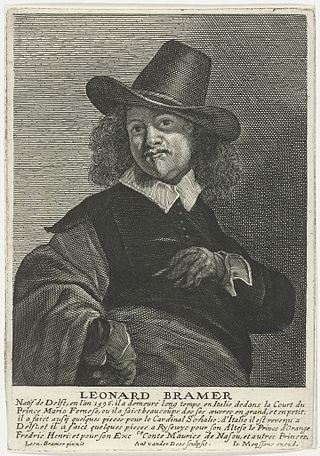
Leonaert Bramer, also Leendert or Leonard, was a Dutch painter known primarily for genre, religious, and history paintings. Very prolific as a painter and draftsman, he is noted especially for nocturnal scenes which show a penchant for exotic details of costume and setting. He also painted frescos—a rarity north of the Alps—which have not survived, as well as murals on canvas, few of which are extant. Bramer is one of the most intriguing personalities in seventeenth-century Dutch art.

Jan Massijs or Jan Matsys was a Flemish Renaissance painter known for his history paintings, genre scenes and landscapes. He also gained a reputation as a painter of the female nude, which he painted with a sensuality reminiscent of the school of Fontainebleau.
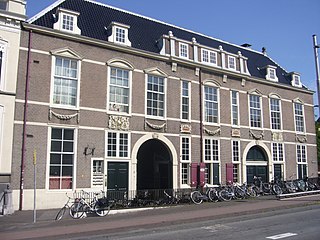
The Confrerie Pictura was a more or less academic club of artists founded in 1656 in The Hague by local art painters, who were unsatisfied by the Guild of Saint Luke there.

Jan Jacobszoon Hinlopen was a rich Dutch cloth merchant, an officer in the civic guard, a real estate developer in the Jordaan, alderman in the city council and a keen art collector. He would have been elected as a burgomaster, if he had not died at the age of forty, an age considered acceptable to be eligible. He was a prominent patron of the arts in his time, and there is some speculation on being an influential protector of Rembrandt and it is likely that he had good connections with Gabriel Metsu. Hinlopen, like his father-in-law, Joan Huydecoper I, is known in art history because of the poems by Jan Vos reciting the paintings in his house and members of the family. These paintings are spread all over the world, the poems nearly forgotten.

Johan de Graeff, also Jan de Graeff - patrician of Amsterdam, Free Lord of Zuid-Polsbroek - was a member of the De Graeff - family from the Dutch Golden Age. His political Position was that of the Dutch States Party.
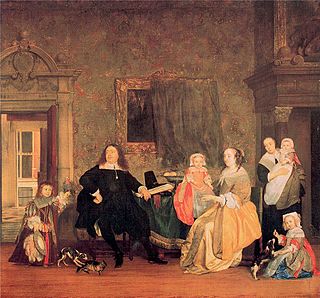
The Portrait of the Family Hinlopen or Family of burgomaster Gillis Valckenier is a painting Dutch Golden Age painter Gabriël Metsu made c. 1663. It is part of the collection in the Gemäldegalerie, Berlin. There have been various ideas among art historians as to which family is actually represented, with the two main candidates being the families of Jan J. Hinlopen or Gillis Valckenier, both wealthy and powerful figures in Amsterdam at the time.

Hendrik van Streek or Hendrick van Streeck was a Dutch painter and sculptor. He is known for his paintings of church interiors and still lifes.
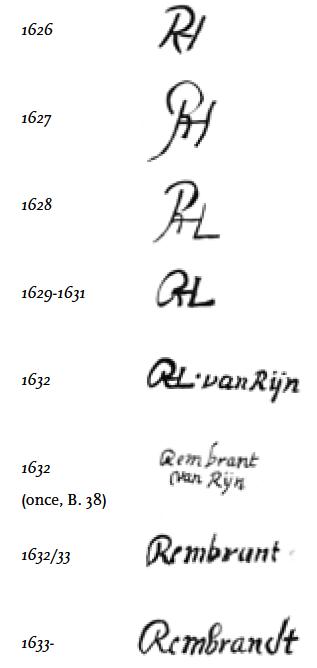
The Rembrandt Research Project (RRP) was an initiative of the Nederlandse Organisatie voor Wetenschappelijk Onderzoek (NWO), which is the Netherlands Organization for Scientific Research. Its purpose was to organize and categorize research on Rembrandt van Rijn, with the aim of discovering new facts about this Dutch Golden Age painter and his studio. The project started in 1968 and was sponsored by NWO until 1998. Research continued until 2014. It was the authority on Rembrandt and had the final say in whether a painting is genuine. The documentation generated by the project was transferred to the Netherlands Institute for Art History and renamed the Rembrandt Database.

The Procuress is a 1656 oil-on-canvas painting by the then 24-year-old Johannes Vermeer. It can be seen in the Gemäldegalerie Alte Meister in Dresden. It is his first genre painting and shows a scene of contemporary life, an image of mercenary love perhaps in a brothel. It differs from his earlier biblical and mythological scenes. It is one of only three paintings Vermeer signed and dated. In 1696 the painting, being sold on an auction in Amsterdam, was named "A merry company in a room".

The Vrouwenhuis on Melkmarkt 53 in the Dutch city of Zwolle is a former old age home for women. It is now rented as separate apartment units for students, while housing a small museum on the ground floor that is only accessible by special request.

Jan Gildemeester Jansz. was a Dutch art collector.
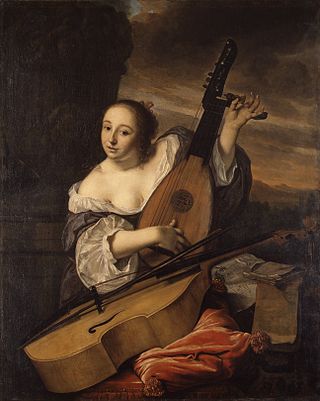
The Musician (1662) is an oil on canvas painting by the Dutch painter Bartholomeus van der Helst. It is an example of Dutch Golden Age painting and is part of the collection of the Metropolitan Museum of Art.

Interior with a Man Reading a Letter and a Woman Sewing is an oil painting on canvas executed c. 1670–1674 by the Dutch artist Pieter de Hooch, now in the private Kremer Collection.
Eduard Siegfried"Eddy"de Jongh is a Dutch art historian specialized in iconography. He was professor of art history with a teaching assignment in iconography at Utrecht University between 1976 and 1989.
Mariecke van der Linden is a Dutch visual artist and opera composer. She works on music videos as an art director in the field of set design, costumes and styling. Furthermore she makes oil paintings and installations. Van der Linden is known for her portraits of prominent Dutch people such as Eberhard van der Laan, Johan Cruijff en Wubbo Ockels.

Seated Girl in Peasant Costume is an oil-on-panel painting by Dutch artist Gerard ter Borch, created c. 1650. It is held in the Rijksmuseum, in Amsterdam.

The Concert is an oil on panel painting by the Dutch artist Gerard ter Borch, created c. 1673–1675. The work is held in the Gemäldegalerie, in Berlin.

Ariane van Suchtelen is a Dutch art historian and museum curator, currently at the Mauritshuis.
Gero Seelig is a German art historian and curator based in Schwerin, Germany. He is the Old Masters Curator at the Staatliches Museum Schwerin, in Schwerin, where he has worked since 2001. He is specialized in German and Dutch artists from the sixteenth and seventeenth centuries and has published extensively on prints, drawings, and paintings from these periods.

















